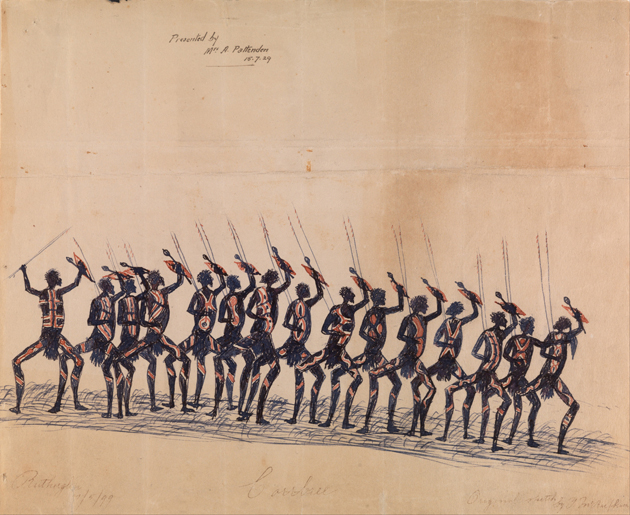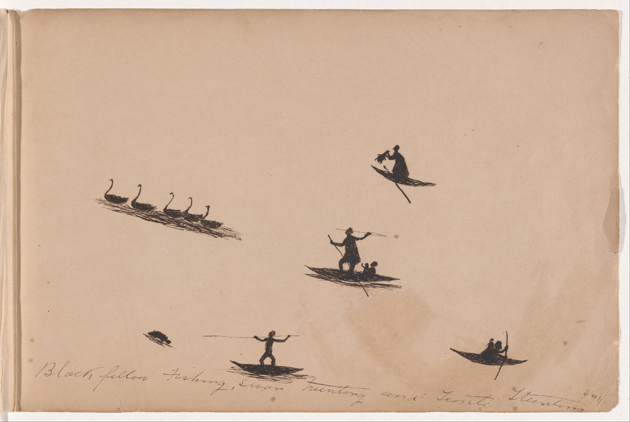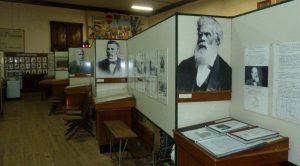Tommy McRae’s sketchbooks tell of life in his Home country of Wahgunyah before and after white man invaded it.
Born in the 1830s into the Wiradjuri people whose homelands extend across the central and southern parts of NSW, Tommy grew up with traditions of carving and weaving in his midst.
Schooled in these traditions McRae draws using directional line reminiscent of a carving action; wielding a variety of line he deftly steers long, short and sinewy marks towards the finest detail and the main action in his works. He describes his country in a simple silhouetted style born of love and detailed observation.
McRae was an astute and independent man. Sometimes described as an entrepreneur, he dressed in European clothes and refrained from both tobacco and alcohol but was an inveterate gambler. He generated an income by making and selling his drawings, boomerangs and other artefacts.
Working exclusively in pen and ink, Tommy charged 10 shillings per sketchbook—customers were required to supply both the standard 8 x 10 inch sketchbook and the pen and ink. They were instructed to return at a later date to collect their illustrated book.
Tommy tells his stories from the ground up. Using strong horizontal lines he defines this ground, preparing it as platform and stage, and signaling for viewers the fundamental importance of Country for Aboriginal people. He draws on story-telling traditions where episodes of daily events pause briefly in campfire light before being captured into myth and memory. McRae tells his stories as an ancient animator might, compiling frame after frame of illustrations; chapters of Aboriginal daily life and the impacts of colonisation in simple and uncoloured truth.
McRae tells his stories as an ancient animator might, compiling frame after frame of illustrations; chapters of Aboriginal daily life and the impacts of colonisation in simple and uncoloured truth.
Many of these sketchbooks are in museums and galleries across NSW and in several of the large collecting institutions such as the State Library of NSW, the Art Gallery of NSW, the National Gallery of Australia, the National Museum of Australia and the National Gallery of Victoria. One such sketchbook, now known as the Lucas Sketchbook, passed through Tommy McRae’s hands to be illustrated—given to him by an eleven year old Englishboy, Richard Lucas, who required a set of McRae’s illustrations as a gift for his brother dying of tuberculosis in England.
The Lucas Sketchbook was found recently in the bottom of a sea chest having made its way as a treasured family possession firstly to Zimbabwe and then on to South Africa. The family recently returned it to Australia where for a handsome sum, it was bought by the National Library.
Throughout his life McRae attracted strong patrons. The Wahgunyah Post Master, Rodrick Kilborn and local doctor William Lang both assisted him in negotiating the punitive bureaucracy of the The Board for the Protection of Aborigines. Through his patrons support and the proceeds of his art, McRae managed to remain independent of the dreaded mission system though his children were forcibly removed from him in the late 1800s, despite his attempts to relocate them across the Murray River into NSW to escape the hands of the Victorian authorities.
The Corowa Federation Museum has several of Tommy McRae’s works in their collection. On display today, are a number of high-quality photographic facsimiles depicting the hunting of emus and kangaroo, ceremonial scenes in which the participants wield weapons of war decked out in their body paint, and a single episode of dancers wearing brush about their lower legs whilst their spears are decorated with flags.
So drop in and spend some time with Tommy and the landscapes that were so dear to him– you’ll be captivated by the poignant detail and depiction of Aboriginal life at a time when their traditional lifestyle was systematically being destroyed.
Many thanks to Hilary Jankelson who generously gave her time and insight to M&G NSW when researching this article. Hillary is currently completing a PhD on the Art of Tommy McRae at Melbourne University.
Also thanks to Alan Handberg of Corowa Historical Society.
Tommy McRae is one of the featured artists in Home Aboriginal art from NSW; an education resource published by the Art Gallery of NSW.
View McRae’s Home Country on the Aboriginal Language Map.









